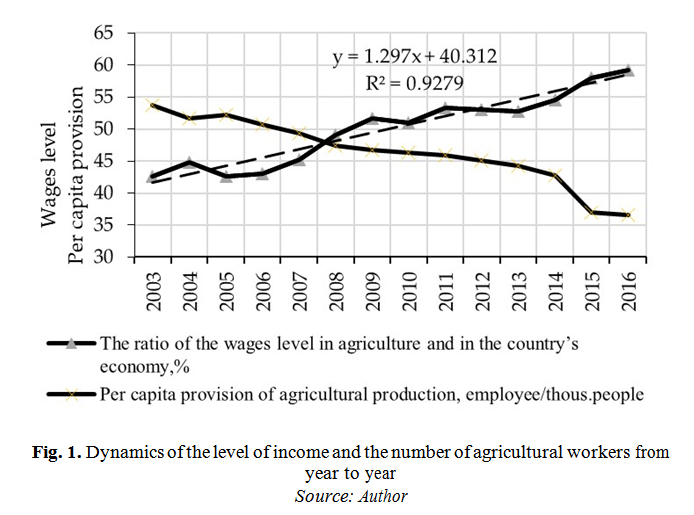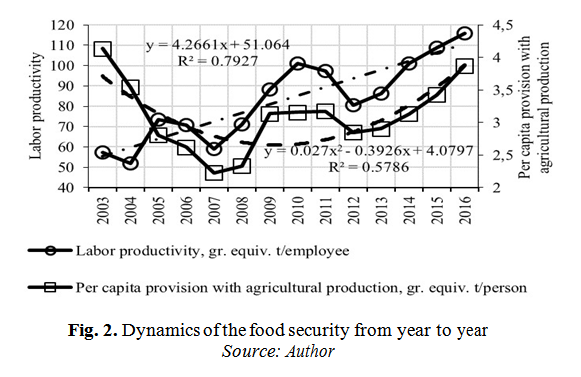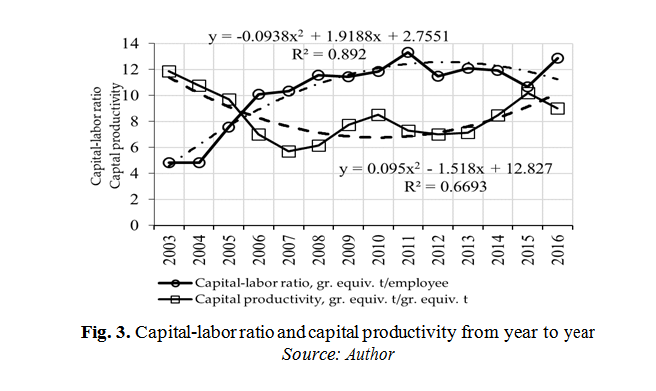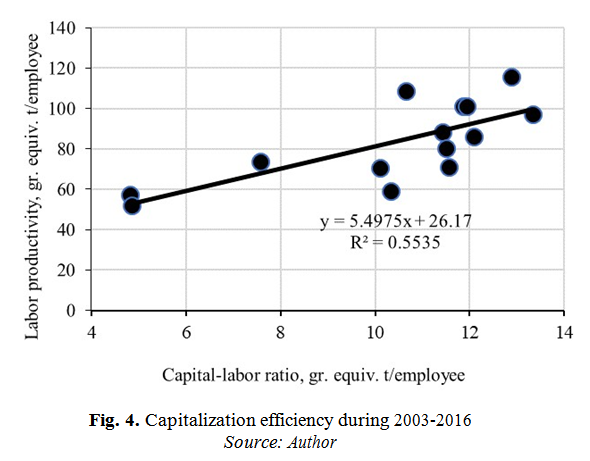Capitalization as a factor of agricultural production intensification

Abstract
The purpose of the study was to identify the quantitative parameters of capitalization and its influence of effectiveness of resources of agricultural production. According to federal statistics data, some tendencies in changing labor resources were identified (the indicator concerning the number of agricultural workers per thousand people was analyzed) and shifts in wages in agriculture and in the country’s economy. The reduction in the number of people employed in the agrarian sector of the economy (with the average annual outflow being 1.19 per thus. people) and low rates of wages convergence (by 14.7% over 13 years) made it possible to draw the conclusion about the labor factor replacing by the investment and intensification factors of the agrarian economy. To assess the effectiveness of agricultural production, the average per capita provision with agricultural products (gr. equiv. t) per capita was used, which in conditionally natural units characterizes the level of food security in tons of grain equivalent per capita of the country every year. A steady increase of this indicator in Russia has been observed since 2007. An annual increase in labor productivity being 4.26 gr. equiv.t is also established per employee, which made it possible to increase the level of efficiency when using labor resources by twice during 2003-2016. The dependence of labor productivity on its capital- labor ratio is close to linear. Each point of the capital-labor ratio increases equals to 5.4975 points of the effect increase given in standard- natural units.
Table of Contents:
1. Introduction
2. Literature Review
3. Methodology
4. Empirical Findings
1. Introduction
Agrarian intensification is understood to be the development of agricultural production by increasing productivity. Urbanization and the collapse of the social rural infrastructure predetermine the outflow of qualified labor from the sphere of agricultural production. In this regard, the preservation and enhancement of food security makes the study urgent. The main direction to expand agricultural production is to introduce automated capital-intensive technologies that do not require significant labor resources. Thus, the study of the process of replacing labor with capital as a capitalization process of resource potential characterizes the urgency of the study.
2. Literature Review
The analysis of publications on the studied topic showed the efficient use of resources in agriculture to be of primary interest in many countries.
The problems caused by the rural population downsizing and concerns over food security are characteristic not only of Russia, but also of similar agriculturally developed countries, particularly, of Australia (Millar, 2012).
The methods for studying are being developed in the direction of analyzing large amounts of data and including the maximum number of factors in the models. Cobb-Douglas production function, proposed in 1927, has been used by agrarian economists since the 30s-40s, and most widely since the 50s of the 20th century (Biddle, 2011). Its use makes it possible to assess the joint impact of the main production factors, though there are significant limitations due to the presence of the social factor that has a complex effect on the agricultural productivity, as well as the need to consider the price parameters of production resources. However, in its modified form, it is still used up to now (Uzawa, 1962), (Kubik, 2015), (Duffy, 2000). When assessing the influence of many factors, multifactor linear models are used (Gadanakis, 2015), the index method being also used to assess the influence of the dynamics of factors (Christensen, 1975), (O’Donnell, 2012).
3. Methodology
The hypothesis of the study. Along with the outflow of labor resources, the introduction of capital-intensive technologies forms the process of increasing capital to preserve the level of food security of the national economy. Therefore, the growth of labor productivity as a result of the supporting the labor resources with capital determines agrarian intensification. In this regard, capitalization is supposed to be a factor of agrarian intensification, and the growth of capitalization leads to an increase in the return of the production resources involved.
To confirm the hypothesis, the following tasks were consistently solved.
- The economic security of the agrarian sector concerning labor resources and the wage level was analyzed.
- The average people’s supply with agricultural products (characterizes the effectiveness of agricultural production) and labor productivity (characterizes the effectiveness of the use of labor resources) were analyzed.
- The capital-labor ratio (the indicator of available resources, characterizes the ratio of capital and labor resources) and capital productivity (characterizes the effectiveness of capital utilization) were analyzed.
- The relationship of labor productivity and capital productivity were analyzed.
Materials and methods used to study. The adjusted data of the statistical registers of Federal State Statistics Service (Rosstat) were used as initial ones.
1. One of the main issues of economic research is the commensurability of cost data over time periods. The complexity of the issue lies in the significant variation of the inflation component for comparison. A typical solution is to introduce a neutral conventional unit, such as the US dollar, energy and other equivalents, which is also used to analyze the efficiency of resource usage in agriculture (Wang, 2014). In our case, we use a ton as the grain equivalent (abbreviated as gr.equiv.t), which corresponds to the statistical register indicator “agricultural producers’ average prices in the Russian Federation, wheat average per year, rubles per ton”1:
WET = I: PW (1)
WET – the corrected indicator as wheat equivalent ton, Mt; I – the value indicator, Rubles;
PW – wheat price, Rubles per Mt.
By transferring cost indicators into in-kind, it is possible to eliminate the influence of the price factor that is dependent on inflation, and thus the short- and medium-term price fluctuations. Long-term changes of price ratios will obviously result in intersectoral flow of capital, which may cause changes in the size of investments considered in the models used.
To assess the supportability of agricultural production with labor resources a relative indicator characterizing the number of workers in agricultural production per thousand people (employee/thous.people) can be used. Indirectly, the indicator (in the absence of recommendations for optimizing the mutual ratio of productive resources) makes it possible to estimate the relative (compared with the other sectors of the economy) amount of labor resources in agriculture. It is calculated as the ratio of the indicators “average annual number of people employed in agriculture, hunting and forestry – total number” to the indicator “population in the Russian Federation”. The correlation with the indicator of the total number of people employed in all sectors of the economy is irrational, since the people employed in the agricultural sector satisfy the food needs of all the inhabitants of the country, and it is also necessary to bear in mind the existence of the problem of shady employment. Another argument for using this indicator is the possibility of comparing the indicators of the resource supportability (the supportability with labor resources) of various sectors of the economy.
The ratio of wages in the agricultural sector to the economy-wide level of wages is calculated as the ratio of the data “average monthly employees’ wages nominally accrued in organizations according to economic activities (in accordance with OKVED-2007) in the Russian Federation” for the sector “agriculture, hunting and forestry” to the similar indicator for “economy-wide”. This indicator characterizes the differentiation of the cost of labor resources in the agriculture and the economy, as well as the level of income of workers in the industry compared with other sectors of the economy.
2. Average supportability with agricultural products gr. equiv.t /thous people. To find this indicator, the statistical registers “Agricultural products according to farm categories (actual prices)”5, “Export of food products and agricultural raw materials (except textiles)”6, “Import of food products and agricultural raw materials (except textiles)”7, “Population of the Russian Federation”8. By subtracting the export from the sum of production and import, the values of the population supply (the volumes of consumption and carry-over stocks) with agricultural products are obtained. The indicator of average supply is determined by dividing the obtained value of the population supply with agricultural products by the population size adjusted for the grain equivalent (see Formula 1).
Average supply essentially characterizes the level of food security, i.e. the level of food security in tons of grain equivalent per inhabitant of the country per year. Obviously, the physical volume of food will depend on the degree of processing of agricultural products: the higher this degree, the more significant is the difference in the physical volume of food and the conventional ton of grain equivalent.
Labor productivity is found as the ratio of the indicator “agricultural products according to farm categories (actual prices)”2 to the indicator “average annual number of people employed in agriculture, hunting and forestry – total number”3.
3. The indicator “capital-labor ratio” is found as the ratio of the statistical registers “investment in basic capital according to the types of economic activity, agriculture, hunting and forestry”4 to the indicator “average annual number of people employed in agriculture, hunting and forestry-total number”5 adjusted for grain equivalent (see Formula 1).
The indicator “capital productivity” is defined as the ratio of statistical registers “agricultural production by farm categories”6 to “fixed capital investment by economic activity, agriculture, hunting and forestry”7 adjusted for the grain equivalent (see Formula 1).
4. The dependence of labor productivity as a criterion of production intensity on the capital-labor ratio as a criterion for the capitalization of labor resources determines the dynamics of the replacement of labor resources with capital. The ratio of these indicators determines the capital productivity as an indicator of the effectiveness of capital.
The obtained indicators formed dynamic series and according to the graph-functional analysis were approximated with functional dependencies based on the criterion of maximizing the accuracy of approximation R2. One can note the following peculiarity of approximation in MS EXCEL: the construction of trend dependencies (tendencies) when using the function argument as the ordinal number of any year within the period under consideration, i.e., 2003 being the first year within the period 2003-2016, corresponds to the unit value of the approximated dependence.
4. Empirical Findings
Analysis of the dynamics of the average per capita provision of agricultural workers (Fig. 1) reveals a tendency of the form y=-1.1923x + 55.372 (R²=0.9227).

Obviously, there is a steady outflow of labor resources from agricultural enterprises, with 1.19 people per thousand people being an average annual tendency. During 2003-2016, the load for ensuring food security per worker in agricultural production increased by 1.47 times. In 2003 and 2016 the employees’ number was 53.79 and 36.61 per thousand people, respectively. Hypothetically, with such a tendency being stabile, in 30 years there won’t be any labor resources in agriculture. This tendency corresponds to the general situation of reducing the employees’ number in the agricultural sector of the economy in developed countries (Millar, 2012), (Ji, Yu, & Zhong, 2012), (McNamara & Weiss, 2005), (Mundlak, 2005), which is manifested in the employment growth in non- agricultural sectors of the economy and additional income from non- agricultural activities.
When considering the main driving force of inter-sectoral migration, i.e., the differentiation of wage levels, there was revealed a tendency to raise wages in rural areas up to the average level in the economy. This tendency is well approximated by a linear function of the form y = 1.297x + 40.312 with the approximation validity coefficient R² = 0.9279. Thus, the gap in wage levels in rural areas and in the economy decreased from 55.45% in 2003 to 40.74% in 2016. This tendency being kept to, the level of employees’ wages in agricultural enterprises will correspond to the general economic level in 31 years. The upward tendency in the wage level in the agricultural sector is also observed in other countries, particularly in China, which leads to shifts in the proportion of agricultural production resources due to the substitution effect (Liu, Hu, Jetté-Nantel, & Tian, 2013).
Probably, such insignificant changes in the level of income cannot stimulate the attracting of labor resources in agriculture in the current situation. Consequently, the relative shortage of labor resources can be compensated by the investment factor, which replaces the labor one. Hence, the growth of capitalization can be the main source for intensification of agricultural production.
The analysis of statistical data proves that there are some positive changes in supplying the population with agricultural products (Fig. 2) as the main criteria for food security.

The population’s supply with agricultural products has a pronounced parabolic dependence with significantly varied values of indicators from year to year. The dependence has the form y = 0.027x2 - 0.3926x +
4.0797 (R² = 0.5786). The tendency towards a decrease in the value of the indicator of the population’s supply with agricultural products, and consequently, the level of food security observed before 2007, is likely to be the starting point for the subsequent import substitution and domestic production increase. At the same time, labor productivity in agriculture grew throughout the analyzed interval (the tendency of the form y = 4.2661x + 51.064; R² = 0.7927).
Thus, the annual increase in labor productivity of 4.26 gr. equiv. t /employee resulted in a 2-fold increase in the efficiency of used labor resources from 57.21 (2003) to 115.93 (2016) gr. equiv.t per worker. This led to the population’s supply with agricultural products at the level of 3.87 gr. equiv. t per person. From 2007-2008 the tendencies in labor productivity and the supply of agricultural products can be considered as synchronized, i.e., the increase in the level of food security of the Russian Federation is determined by labor productivity. Quite significant fluctuations in labor productivity could be caused by unaccounted factors leading to changing of the resultant mark, even if there is a constant tendency for changing the proportions of production resources (Tozer & Villano, 2013).
Let us consider the reasons for the growth of labor productivity along with the outflow of labor resources from the industry (Fig. 3). The growth factor is likely the process of capitalization.

When analyzing the dynamics of capital-labor ratio, there occurs a tendency of the type y = - 0.0938x2 + 1.9188x + 2.7551; R² = 0.892. The capital-labor ratio increased from 4.82 (2003) to 12.87 gr. equiv. t /employee, i.e., by 2.67 times. Thus, the growth of capital-labor ratio by 2.67 times causes a 2-fold increase in labor productivity (compare Fig. 2 and 3). Since labor productivity is growing more slowly than the capital- labor ratio, it can be assumed that some part of the capital is spent on the compensation of the labor factor. The investments that lead to improved working conditions or a relative increase in wages (for example, because of a higher level of wages for more skilled labor) can serve as an example.
Let us consider the capitalization effectiveness as an indicator of capital productivity when increasing labor productivity and the revealed pattern of the form y = 0.095x2 - 1.518x + 12.827 (R² = 0.6693). A certain failure of capital return during 2006-2007 is obvious up to 5.70 points, but the subsequent (starting from 2008) increase in labor productivity (see Fig. 2) made it possible to increase the efficiency of capitalization up to 9.0 points by 2016, i.e. by 1.57 times.
Let us consider the dependence of labor productivity on its capital- labor ratio in the form y = 5.4975x + 26.17 (R² = 0.5535) (Fig. 4).

Validation of models (Fig.1-4) is presented in Table 1.

Thus, a moderate tendency of productivity growth in increasing the capital-labor ratio is revealed. Each unit of capital equals to 5.4975 units of the result (effect). The level of capital (investment) efficiency in agricultural production in terms of labor productivity is more than 500%.
The objectives of this study did not include assessing the capital structure, but it can be assumed that it differs from the one in the developed countries due to the relatively underestimated land resources in Russia.
5. Conclusions
The average annual outflow of agricultural labor resources equalling 1.19 people per thousand people increased the load on agriculture by 1.47 times to ensure food security.
There has been an annual increase in wages in Russian agriculture by 1.29% against to the economy-wide one. According to this tendency the level of wages in agricultural enterprises will reach the economy-wide one in 31 years.
The annual increase in labor productivity of 4.26 gr. equiv. t/employee caused the increase in the efficiency level of used labor resources by 2 times. This led to restoring the level of food security as the people’s supply with agricultural products to the level of 3.87 gr. equiv. t per capita.
The capital-labor ratio during 2003-2016 increased by 2.67 times, which resulted in a 2-fold increase in labor productivity.
The increase in labor productivity during 2003-2016 increased the capitalization efficiency by 1.57 times. Each unit of the capital-labor ratio increase equals to 5.4975 points of the effect increase, given in standard- natural units.
Thus, as a result of solved tasks consistently, the hypothesis about the importance of capitalization as a factor of intensification of the agrarian economy has been confirmed. The goal of the study, i.e., to identify the quantitative parameters of the capitalization factor influence on the effectiveness of the used agricultural production resources, is achieved.
1http://www.gks.ru/wps/wcm/connect/rosstat_main/rosstat/ru/statistics/tariffs/#
2http://www.gks.ru/wps/wcm/connect/rosstat_main/rosstat/ru/statistics/enterprise/economy/#
3http://www.gks.ru/wps/wcm/connect/rosstat_main/rosstat/ru/statistics/wages/labour_force/#
4http://www.gks.ru/wps/wcm/connect/rosstat_main/rosstat/ru/statistics/enterprise/investment/nonfi nancial/#
5http://www.gks.ru/wps/wcm/connect/rosstat_main/rosstat/ru/statistics/wages/labour_force/#
6http://www.gks.ru/wps/wcm/connect/rosstat_main/rosstat/ru/statistics/enterprise/economy/#
7http://www.gks.ru/wps/wcm/connect/rosstat_main/rosstat/ru/statistics/enterprise/investment/nonfi nancial/#
The Authors:
SHABANOV Timofey Yurievich [1]
KOPCHENOV Alexei Alexandrovich [1] [2]
[1] South Ural State Agrarian University, Troitsk, the Russian Federation (RUSSIA).
[2] Financial University Under the Government of the Russian Federation, Chelyabinsk (RUSSIA).
Contributo selezionato da Filodiritto tra quelli pubblicati nei Proceedings “Ecological Agriculture and Sustainable Development - 2019”
Per acquistare i Proceedings clicca qui.
Contribution selected by Filodiritto among those published in the Proceedings “Ecological Agriculture and Sustainable Development - 2019”
To buy the Proceedings click here.



